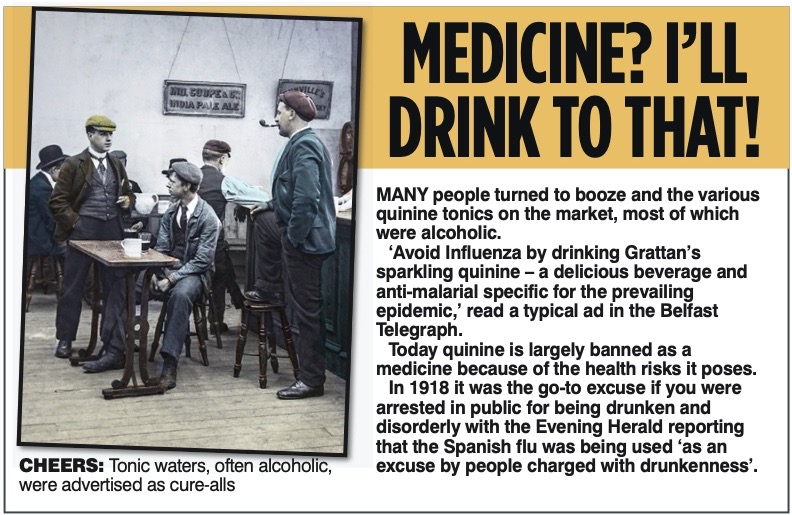By: Michael O’Farrell – Investigations Editor.
TODAY’S Covid-19 pandemic is already being likened to the 1918 Spanish flu that killed 20,000 people in Ireland and between 50 and 100 million globally.
But we are lucky, Covid-19 does not appear to have as high a death rate as the 1918 influenza – and has not come hot on the heels of a World War.
Here we take a look at Irish newspaper coverage of the 1918 influenza crisis, providing a searing glimpse of the last time a pandemic took hold of the country.
In many ways the fear experienced by those affected more than 100 years ago must have been similar to how many of us feel today.
Then, as now, schools and entertainment venues closed and sporting events – such as the 1918 All-Ireland Final between Tipperary and Wexford – were postponed.
Every day for months newspaper front pages across Ireland told appalling stories of death and bitter tragedy, But in many other ways our predecessors were far worse off.
Ireland was, of course, still under the control of Britain, which was still at war – a conflict that drew hundreds of thousands of the healthiest citizens away to fight.
Many more adults – vital doctors and medical staff included – had been interned under draconian ‘protection of the Realm’ powers used by the British authorities to crack down on nationalist agitators.
The population had already been struggling to scrape by on meagre war-time rations before the pandemic struck.
And with no phone, internet, electricity, running water or sanitation ‘, the running water or sanitation, the situation was in many ways very different to that facing us more than a century later.
We should, given the many advances in society, now be able to cope better today than our ancestors did.

But the newspaper articles of 1918 are frightening to read – knowing what we are now facing in the coming weeks and months.
Addressing the nation on St Patrick’s Day, Taoiseach Leo Varadkar, warned that were in the calm before the storm.
He said nothing of the possibility of more than one storm – but that’s just what happened in 1918 as the epidemic first flared in July before coming back in the autumn in an even deadlier tidal wave that continued into the following year.
On Wednesday, July 10, the Irish Independent reported that the ‘plague continued to spread in Dublin with 33 deaths in the previous week’.
The report also touched on events in the UK.
‘In Birmingham a doctor was stopped on the street by a woman who said she was suffering from influenza and while he was speaking to her she collapsed and died.’
‘Keep out in the air, keep healthy and go about your business as usual,’ the Evening Herald advised on July 11.
‘There is no danger whatever if people just take reasonable measures. Above all, keep the sewers flushed.’
In fact that week saw the first wave reach its peak in Ireland as deaths in Dublin alone climbed to 76.
But worse was to come. Far worse.
On Wednesday, October 10, the Evening Herald front page reported the second wave of the ‘epidemic still raging in Dublin’ and ‘600 cases in Bray’ since the previous Saturday’.
The level of deaths was such that the paper reported that gravediggers were struggling to keep up.
The previous day, The Nationalist newspaper in Thurles had reported the plight of a 1916 veteran who’d carried the coffin of a fellow volunteer killed by influenza before returning home where he himself was struck down and died.

‘The influenza scourge has visited Thurles with fearful malignancy and the epidemic is at present raking the township like a plague,’ the paper reported.
‘Almost every other household has some of its members down with the sickness.’ In Dublin, meanwhile, things were no better.
‘MYSTERIOUS MALADY – ‘Flu Spreading To An Alarming Extent’ – read the front page on Tuesday, October 22, in between stories about a possible German surrender and the ongoing war in France.
On October 25 the Herald quoted a London Star report saying there were ‘practically no coffins to be had.
‘It is quite usual for bodies to wait several days without them’. In Dublin the paper reported: ‘Many of the medical profession themselves were prostate with this terrible disease. There was a want of nurses, a want of medical appliances and a want of medical accommodation’.
‘EPIDEMIC TRAGEDIES,’ read the front page of the Herald on October 28.
‘Provinces Now In The Grip Of New Flu.’ ‘The military authorities have notified all theatre managers in Dublin that all cinemas and theatres in Dublin district are “out of bounds” for members of his Majesty’s Forces,’ the article reported.
The piece also included sensational details of an actor dying in his dressing room as he prepared to go on stage, tragic victims being buried on their wedding day and the ill dropping dead in the street.
On October 29 the lord mayor of Cork – TC Butterfield – wrote to the Irish Examiner to warn of the danger of attending places where people congregate such as schools, concert halls, theatres and places of amusement’.
‘In view of the serious outbreak of influenza, and with the object of preventing its further spread in the city, permit me to avail of your columns to earnestly appeal to my fellow citizens to avoid frequenting all places of amusement or entertainment in the city until such time as the epidemic has passed away,’ his letter reads.
‘I have conveyed a request to the proprietors of such houses to close them while the epidemic prevails.’
On November 9 the Herald reported a record 562 Dublin deaths in the previous week – a death rate of 65.5 per 1,000. The mean death rate for the previous decade had been 18.6 per 1,000.
This was the peak of the second wave.
‘EPIDEMIC NOW ‘HELD’ the headline that day read. ‘The epidemic itself is now held in Dublin and the death rate is on the decline,’ a physician told the Herald.
‘You may take that as certain. But there are still thousands of influenza patients in the city and suburbs. These must be carefully watched. I would be strongly against re-opening of schools at this juncture or any relaxation whatsoever of precautions or public health regulations.’
The article went on to list the day’s burials – 40 of them scheduled for Glasnevin cemetery before lunch that day with additional bodies lying in vaults awaiting burial and more expected to arrive on spec.

In London, meanwhile, that day’s Herald also reported 510 Omnibus motor drivers and conductors were down with flu – and 1,412 policemen were out sick.
Events in the provinces were also reported by the Herald.
‘In Carrickmore and Greencastle districts the epidemic has almost assumed the form of a plague,’ the paper stated on December 9.
‘A terror of the disease seems to have gripped the people of some districts and stories are told of whole families being unable to attend to themselves; whilst the fear of infection by the neighbours was so great that they would not go into the houses to give the sufferers even a drink to quench their thirst.’
The same edition detailed a rural dance where 30 couples had all been infected with several dying as the ‘epidemic swept Irish country places’.
In mid-December the Coal Controller’s Department placed an ominous ad in many papers. Influenza was drastically affecting coal production.
‘The output of coal is dangerously low in England, Scotland and Wales and it is anticipated it will not be possible to maintain the usual imports to Ireland in the next five weeks,’ the notice read.
‘All concerned are urgently requested to effect every possible economy in consumption.’
By year’s end some had begun to take stock – though the influenza remained present to varying degrees globally throughout 1919.
‘EPIDEMIC CASUALTIES MORE DEADLY THAN FIVE WARS,’ read the front page headline of the Anglo Celt newspaper on December 28.
The paper reported that worldwide ‘6,000,000 had perished from influenza within the past 12 weeks’.
There had been, the paper continued, 3,000,000 deaths in India alone and ‘1,200 deaths daily in Barcelona’.
Proving, even back then, that the world was all connected.
